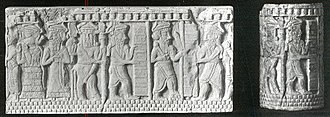Geoy Tepe
| Location | Iran |
|---|---|
| Region | West Azerbaijan province |
| Coordinates | 37°31′05″N 45°08′42″E / 37.518°N 45.145°E |
| Type | tell |
| History | |
| Abandoned | 1200 BC |
| Periods | Early Bronze Age |

Geoy Tepe (also Gök Tepe) is an archaeological site in northwestern Iran, about 7 kilometers south of Urmia (Reżāʾīya), Gug Tappeh. It was found by an aerial survey of ancient sites in Persia done by Erich Schmidt in the 1930s.
The site's mound is 80 feet (24 m) tall and is situated by a natural spring. T. Burton Brown of Great Britain excavated the site in August 1948. It was found to have been continuously occupied from the 4th millennium BCE until 1200 BCE.[1]
Remains of the earliest stage of the Kura–Araxes culture have been found here.
See also
References
- ^ BURTON-BROWN, T. \95l. Excavations in Azerbaijan, 1948. John Murray, London

